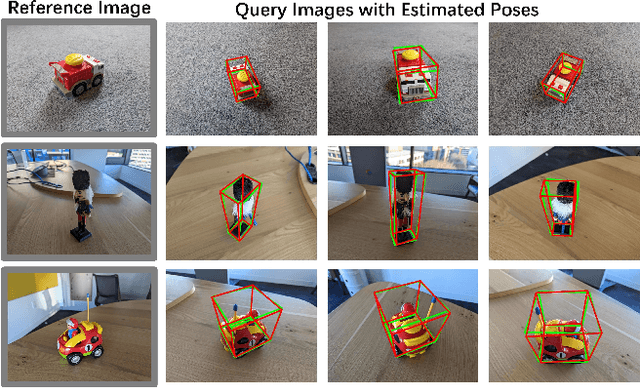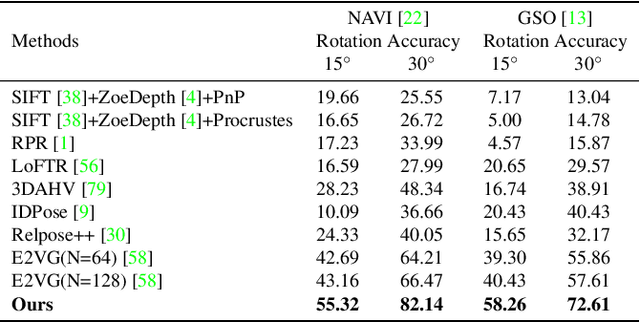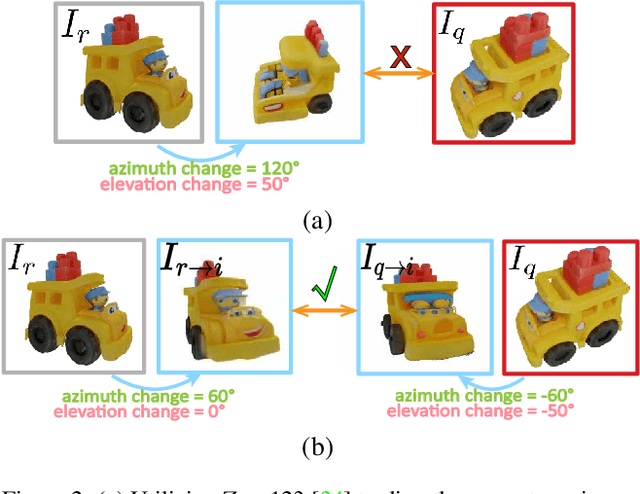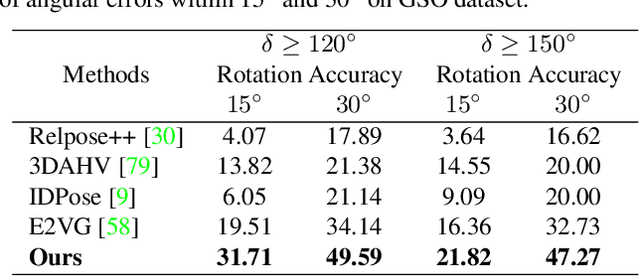Yujing Sun
UniDemoiré: Towards Universal Image Demoiréing with Data Generation and Synthesis
Feb 10, 2025Abstract:Image demoir\'eing poses one of the most formidable challenges in image restoration, primarily due to the unpredictable and anisotropic nature of moir\'e patterns. Limited by the quantity and diversity of training data, current methods tend to overfit to a single moir\'e domain, resulting in performance degradation for new domains and restricting their robustness in real-world applications. In this paper, we propose a universal image demoir\'eing solution, UniDemoir\'e, which has superior generalization capability. Notably, we propose innovative and effective data generation and synthesis methods that can automatically provide vast high-quality moir\'e images to train a universal demoir\'eing model. Our extensive experiments demonstrate the cutting-edge performance and broad potential of our approach for generalized image demoir\'eing.
Generalizable Single-view Object Pose Estimation by Two-side Generating and Matching
Nov 24, 2024



Abstract:In this paper, we present a novel generalizable object pose estimation method to determine the object pose using only one RGB image. Unlike traditional approaches that rely on instance-level object pose estimation and necessitate extensive training data, our method offers generalization to unseen objects without extensive training, operates with a single reference image of the object, and eliminates the need for 3D object models or multiple views of the object. These characteristics are achieved by utilizing a diffusion model to generate novel-view images and conducting a two-sided matching on these generated images. Quantitative experiments demonstrate the superiority of our method over existing pose estimation techniques across both synthetic and real-world datasets. Remarkably, our approach maintains strong performance even in scenarios with significant viewpoint changes, highlighting its robustness and versatility in challenging conditions. The code will be re leased at https://github.com/scy639/Gen2SM.
Towards Practical Human Motion Prediction with LiDAR Point Clouds
Aug 15, 2024



Abstract:Human motion prediction is crucial for human-centric multimedia understanding and interacting. Current methods typically rely on ground truth human poses as observed input, which is not practical for real-world scenarios where only raw visual sensor data is available. To implement these methods in practice, a pre-phrase of pose estimation is essential. However, such two-stage approaches often lead to performance degradation due to the accumulation of errors. Moreover, reducing raw visual data to sparse keypoint representations significantly diminishes the density of information, resulting in the loss of fine-grained features. In this paper, we propose \textit{LiDAR-HMP}, the first single-LiDAR-based 3D human motion prediction approach, which receives the raw LiDAR point cloud as input and forecasts future 3D human poses directly. Building upon our novel structure-aware body feature descriptor, LiDAR-HMP adaptively maps the observed motion manifold to future poses and effectively models the spatial-temporal correlations of human motions for further refinement of prediction results. Extensive experiments show that our method achieves state-of-the-art performance on two public benchmarks and demonstrates remarkable robustness and efficacy in real-world deployments.
LiveHPS++: Robust and Coherent Motion Capture in Dynamic Free Environment
Jul 13, 2024



Abstract:LiDAR-based human motion capture has garnered significant interest in recent years for its practicability in large-scale and unconstrained environments. However, most methods rely on cleanly segmented human point clouds as input, the accuracy and smoothness of their motion results are compromised when faced with noisy data, rendering them unsuitable for practical applications. To address these limitations and enhance the robustness and precision of motion capture with noise interference, we introduce LiveHPS++, an innovative and effective solution based on a single LiDAR system. Benefiting from three meticulously designed modules, our method can learn dynamic and kinematic features from human movements, and further enable the precise capture of coherent human motions in open settings, making it highly applicable to real-world scenarios. Through extensive experiments, LiveHPS++ has proven to significantly surpass existing state-of-the-art methods across various datasets, establishing a new benchmark in the field.
LaserHuman: Language-guided Scene-aware Human Motion Generation in Free Environment
Mar 21, 2024Abstract:Language-guided scene-aware human motion generation has great significance for entertainment and robotics. In response to the limitations of existing datasets, we introduce LaserHuman, a pioneering dataset engineered to revolutionize Scene-Text-to-Motion research. LaserHuman stands out with its inclusion of genuine human motions within 3D environments, unbounded free-form natural language descriptions, a blend of indoor and outdoor scenarios, and dynamic, ever-changing scenes. Diverse modalities of capture data and rich annotations present great opportunities for the research of conditional motion generation, and can also facilitate the development of real-life applications. Moreover, to generate semantically consistent and physically plausible human motions, we propose a multi-conditional diffusion model, which is simple but effective, achieving state-of-the-art performance on existing datasets.
HUNTER: Unsupervised Human-centric 3D Detection via Transferring Knowledge from Synthetic Instances to Real Scenes
Mar 15, 2024



Abstract:Human-centric 3D scene understanding has recently drawn increasing attention, driven by its critical impact on robotics. However, human-centric real-life scenarios are extremely diverse and complicated, and humans have intricate motions and interactions. With limited labeled data, supervised methods are difficult to generalize to general scenarios, hindering real-life applications. Mimicking human intelligence, we propose an unsupervised 3D detection method for human-centric scenarios by transferring the knowledge from synthetic human instances to real scenes. To bridge the gap between the distinct data representations and feature distributions of synthetic models and real point clouds, we introduce novel modules for effective instance-to-scene representation transfer and synthetic-to-real feature alignment. Remarkably, our method exhibits superior performance compared to current state-of-the-art techniques, achieving 87.8% improvement in mAP and closely approaching the performance of fully supervised methods (62.15 mAP vs. 69.02 mAP) on HuCenLife Dataset.
Extreme Two-View Geometry From Object Poses with Diffusion Models
Feb 05, 2024Abstract:Human has an incredible ability to effortlessly perceive the viewpoint difference between two images containing the same object, even when the viewpoint change is astonishingly vast with no co-visible regions in the images. This remarkable skill, however, has proven to be a challenge for existing camera pose estimation methods, which often fail when faced with large viewpoint differences due to the lack of overlapping local features for matching. In this paper, we aim to effectively harness the power of object priors to accurately determine two-view geometry in the face of extreme viewpoint changes. In our method, we first mathematically transform the relative camera pose estimation problem to an object pose estimation problem. Then, to estimate the object pose, we utilize the object priors learned from a diffusion model Zero123 to synthesize novel-view images of the object. The novel-view images are matched to determine the object pose and thus the two-view camera pose. In experiments, our method has demonstrated extraordinary robustness and resilience to large viewpoint changes, consistently estimating two-view poses with exceptional generalization ability across both synthetic and real-world datasets. Code will be available at https://github.com/scy639/Extreme-Two-View-Geometry-From-Object-Poses-with-Diffusion-Models.
A graph-based multimodal framework to predict gentrification
Dec 27, 2023Abstract:Gentrification--the transformation of a low-income urban area caused by the influx of affluent residents--has many revitalizing benefits. However, it also poses extremely concerning challenges to low-income residents. To help policymakers take targeted and early action in protecting low-income residents, researchers have recently proposed several machine learning models to predict gentrification using socioeconomic and image features. Building upon previous studies, we propose a novel graph-based multimodal deep learning framework to predict gentrification based on urban networks of tracts and essential facilities (e.g., schools, hospitals, and subway stations). We train and test the proposed framework using data from Chicago, New York City, and Los Angeles. The model successfully predicts census-tract level gentrification with 0.9 precision on average. Moreover, the framework discovers a previously unexamined strong relationship between schools and gentrification, which provides a basis for further exploration of social factors affecting gentrification.
FreeReg: Image-to-Point Cloud Registration Leveraging Pretrained Diffusion Models and Monocular Depth Estimators
Oct 05, 2023Abstract:Matching cross-modality features between images and point clouds is a fundamental problem for image-to-point cloud registration. However, due to the modality difference between images and points, it is difficult to learn robust and discriminative cross-modality features by existing metric learning methods for feature matching. Instead of applying metric learning on cross-modality data, we propose to unify the modality between images and point clouds by pretrained large-scale models first, and then establish robust correspondence within the same modality. We show that the intermediate features, called diffusion features, extracted by depth-to-image diffusion models are semantically consistent between images and point clouds, which enables the building of coarse but robust cross-modality correspondences. We further extract geometric features on depth maps produced by the monocular depth estimator. By matching such geometric features, we significantly improve the accuracy of the coarse correspondences produced by diffusion features. Extensive experiments demonstrate that without any task-specific training, direct utilization of both features produces accurate image-to-point cloud registration. On three public indoor and outdoor benchmarks, the proposed method averagely achieves a 20.6 percent improvement in Inlier Ratio, a three-fold higher Inlier Number, and a 48.6 percent improvement in Registration Recall than existing state-of-the-arts.
Towards Real-World Burst Image Super-Resolution: Benchmark and Method
Sep 09, 2023Abstract:Despite substantial advances, single-image super-resolution (SISR) is always in a dilemma to reconstruct high-quality images with limited information from one input image, especially in realistic scenarios. In this paper, we establish a large-scale real-world burst super-resolution dataset, i.e., RealBSR, to explore the faithful reconstruction of image details from multiple frames. Furthermore, we introduce a Federated Burst Affinity network (FBAnet) to investigate non-trivial pixel-wise displacements among images under real-world image degradation. Specifically, rather than using pixel-wise alignment, our FBAnet employs a simple homography alignment from a structural geometry aspect and a Federated Affinity Fusion (FAF) strategy to aggregate the complementary information among frames. Those fused informative representations are fed to a Transformer-based module of burst representation decoding. Besides, we have conducted extensive experiments on two versions of our datasets, i.e., RealBSR-RAW and RealBSR-RGB. Experimental results demonstrate that our FBAnet outperforms existing state-of-the-art burst SR methods and also achieves visually-pleasant SR image predictions with model details. Our dataset, codes, and models are publicly available at https://github.com/yjsunnn/FBANet.
 Add to Chrome
Add to Chrome Add to Firefox
Add to Firefox Add to Edge
Add to Edge